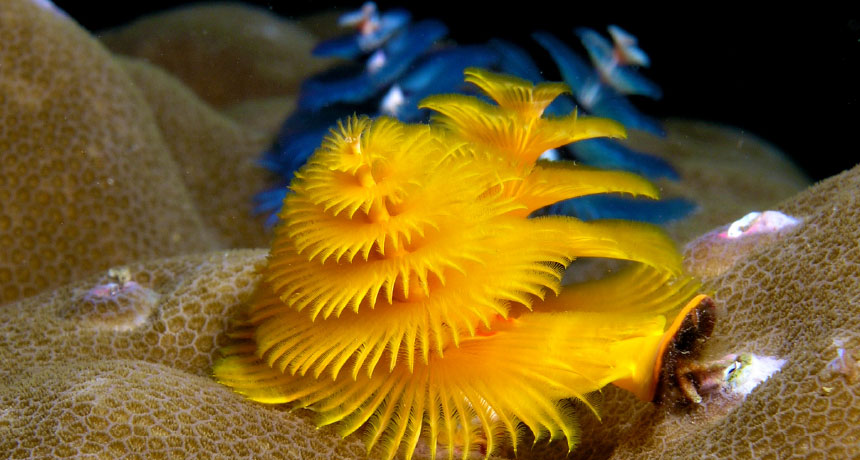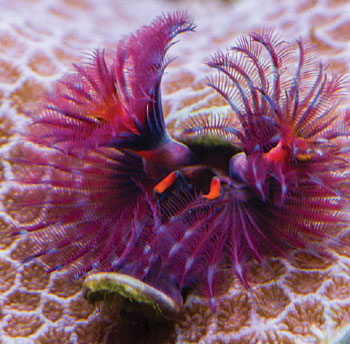Picture This: Christmas tree worms
Marine invertebrates have eyes that breathe, gills that see

These brightly colored trees aren’t plants. They’re the gills of Christmas tree worms. When danger is near, they pull their gills in and hide in tubes below.
NICK HOBGOOD/WIKIMEDIA COMMONS (CC BY-SA 3.0)
By Susan Milius
PORTLAND, Ore. — Christmas tree worms have eyes “in a really silly place,” says Michael Bok. But that, he adds, is just part of their charm.
This widespread marine worm (Spirobranchus giganteus) gets its holiday nickname from its gills: a wildly colored pair of tapering, feathery spires. They stick up from the top of the worm’s buried retreat like the ornamental trees. Bok, of Lund University in Sweden, says he has seen the worms sport gills in red, orange, blue, yellow — even stripes.
When a shadow looms, the treelike gills drop down into a protective tube where the rest of the worm hides. Its eyes, which check for scary things, sit beneath the branches like forgotten presents. To see the bright orange compound eyes, “you have to kind of sneak up on them and look at them from the right angle,” Bok says.
That tucked-under spot limits what the worm’s eyes can do. For instance, they can only see directly in front or behind. To human thinking, the top of a tree seems a better place for lookouts, and another kind of fan worm indeed grows compound eyes there.

Bok described some of his team’s new observations on January 5, here, at the annual meeting of the Society for Integrative and Comparative Biology.
Bok is exploring the largely-unstudied vision of fan worms. They are possibly the only animals growing eyes on their gills. Some parts of the worms have features often seen in a typical visual system. Like other worms, for instance, some have patches of light-catching compounds on the segments of their bodies — even their tails. A lump of light-sensitive tissue in their heads even monitors light-dark cycles. But hidden in their tubes, the worm’s visual bits seem useless for detecting danger. So their emerging gills, which also double as feeding tentacles, went visionary. Evolution scattered them with light-catching molecules or even eyes.
This took some doing. The nerves from these gill eyes don’t go to the usual optic section of the brain. They connect to another, less-well-known area not usually thought to be involved in vision. And the light-sensitive proteins in the eyes — opsins — aren’t typical eye compounds, Bok is finding. They are a form of opsin hardly ever found outside the brain.
Even the fanciest of these gill-based eyes, like those in the Christmas tree worm, may only detect scary shadows. But that’s a lot. Without their make-do warning systems for predators, Bok says, “they’d get their gills and ‘mouth’ ripped off all the time.”
Power Words
(for more about Power Words, click here)
evolution A process by which species undergo changes over time, usually through genetic variation and natural selection. These changes usually result in a new type of organism better suited for its environment than the earlier type. The newer type is not necessarily more “advanced,” just better adapted to the conditions in which it developed.
evolutionary An adjective that refers to changes that occur within a species over time as it adapts to its environment. Such evolutionary changes usually reflect genetic variation and natural selection, which leave a new type of organism better suited for its environment than its ancestors. The newer type is not necessarily more “advanced,” just better adapted to the conditions in which it developed.
gills The respiratory organ of most aquatic animals that filters oxygen out of water, which fish and other water-dwelling animals use to breathe.
invertebrate An animal lacking a backbone. About 90 percent of animal species are invertebrates.
marine Having to do with the ocean world or environment.
opsin A light-sensing protein that is usually found in a part of the eye called the retina.
optics Having to do with vision or what can be seen.
predator (adjective: predatory) A creature that preys on other animals for most or all of its food.
proteins Compounds made from one or more long chains of amino acids. Proteins are an essential part of all living organisms. They form the basis of living cells, muscle and tissues; they also do the work inside of cells. The hemoglobin in blood and the antibodies that attempt to fight infections are among the better-known, stand-alone proteins.Medicines frequently work by latching onto proteins.
tangent (adj. tangential) A new, divergent path from the direction something (or some conversation or some project) initially seemed to be taking.







